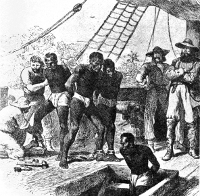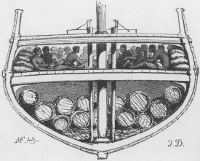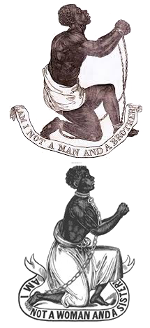The Middle Passage
The journey of enslaved Africans across the Atlantic Ocean, from Africa to North America or South America or the Caribbean, was called by many the Middle Passage. It was the most harrowing part of the transition for captured Africans from freedom to slavery. 
Estimates are that the number of enslaved Africans sent to America from the early 16th Century to the mid-19th Century was more than 12 million, aboard nearly 35,000 ships. As many as 15 percent died during the journey across the ocean. These people died from a variety of causes. For a start, they were tightly packed into the hold of a ship. Men were often chained to the walls or floor of the hold, sometimes chained in pairs. Women were often kept separate from men and not usually chained. They spent the vast majority of their time down below, where they had to hunch over because the hold wasn't tall enough for many of them to stand. Food was brought to them, sparingly. The captain was tasked with transporting potential labor and so had to maintain a semblance of strength in the source of that labor. 
Because these people were kept in such close quarters, diseases spread quickly. They had to provide for their own waste removal needs, if the need was urgent and they were not up on deck. Crews sometimes allowed enslaved people to see the Sun or otherwise be up on deck; some enslaved people found themselves forced to sing and/or dance because a ship's crew was curious about African culture. At the same time, crews would carefully watch for anyone who tried to leave the ship. Many people despaired and chose to end their own lives, and jumping overboard was one of the ways that they did this. (Survival, far from land and in sometimes shark-infested waters, was highly unlikely.) Some crews hung netting around the outside of the ship, to catch anyone attempting to jump. Those who died, for whatever reason, were thrown overboard. 
At first, Europeans who engaged in the slave trade used cargo ships to transport enslaved people. It wasn't long, however, until Europeans built ships designed to carry slaves. Cargo and other smaller ships could transport a few dozen slaves; purpose-built slave ships could carry several hundred. Not all slave ships confined their "cargo" to belowdeck. Some slaves stayed on deck during the journey, often performing tasks to assist or replace the crew. They were chained at various times during the journey–sometimes with wrist manacles, sometimes with leg shackles, and sometimes with both. It was the goal of slave traders to deliver living slaves, so the victims were given food, often just enough to stay alive. Slaves were also often made to dance or do some form of exercise in the sometimes short amount of time that they had on deck. A ship's captain and crew kept slaves in line by keeping them in chains and, at other times, brandishing guns and other weapons. Discipline was harsh, and the slightest infractions were punished by beatings and, in the case of women, other kinds of physical attacks. Revolts were rare, successful ones even moreso. Two well-known takeovers of a slave ship by enslaved people were the revolts aboard the Clare in 1729 and the Amistad in 1839. In the case of the Clare, those enslaved overwhelmed the crew and sailed the ship to landfall near Cape Coast Castle on the Gold Coast. In the case of the Amistad, those enslaved took control of the ship and ordered the crew to sail for Africa; the crew instead sailed closer to the U.S., and the ship was captured; the mutineers, as they were called, were eventually acquitted by the U.S. Supreme Court and declared free. An irony of close contact between slaves and slave ship crews was that the exchange of diseases worked both ways. Africans didn't necessarily have immunity to diseases that some Westerners could survive. (This would continue to be the case in the New World.) At the same time, Africans might have brought with them malaria, yellow fever, and other things for which Europeans had no immunity. A typical voyage through the Middle Passage lasted 60–90 days. Some, however, lasted much longer, punctuated by stops along the way or bouts with bad weather. The total number of voyages through the Middle Passage was in the tens of thousands. Africans who did survive the Middle Passage were then sold into slavery in the New World. Most of them ended up in Brazil, with smaller numbers being put to work in the Caribbean and in North America. Firsthand accounts of the horrors of the Middle Passage are rare. One more well-known account was that written by Olaudah Equiano, who not only survived the journey but also found his way to freedom, published a book about his life, and became famous, in England. |
|
Social Studies for Kids
copyright 2002–2025
David White





